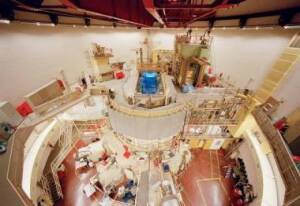by
Brendon Nafziger, DOTmed News Associate Editor | July 23, 2010
Work crews laid down concrete flooring in the High Flux Reactor in Petten, Netherlands, as they put finishing touches on the nearly six-month-long repairs of the downed radioisotope-producing reactor, the Nuclear Research and consultancy Group announced Thursday.
The NRG, which runs the site, now expects the 50-year-old reactor to be fully powered up on Sept. 9, after repair teams refill the reactor's basin with water and conduct safety tests, including a nearly week-long containment test to ensure radiation doesn't escape.
Monitoring the concrete pour.
The re-start should be welcomed by nuclear medicine specialists, as it could help relieve the ongoing isotope shortage. The Petten reactor, along with the National Research Universal reactor in Chalk River, Canada, has been down for repairs for months, leading to a strangling of supplies of molybdenum-99, the parent isotope of technetium-99m, used for some nuclear medicine exams. The NRU reactor, whose repairs finished earlier this month,
got permission from Canadian authorities to re-start and is expected to resume isotope production by the end of July.
Petten floor fix
The concrete floor repairs wrapped up July 13, the NRG said, only weeks after workers
fixed the cooling pipework. Workers discovered leaks in the pipes around two years ago during routine inspections, triggering the reactor's shutdown in February.
Pipe outfitted with
anti-corrosion concrete collar.
In the latest round of repairs, before pouring in the concrete floor, work crews installed reinforcement bars and ventilation pipes, and they sealed joints of the cooling pipes with protective concrete collars. The engineers chose concrete over steel for the collars, as it helped protect the joints from corrosion, they said.
"The collar also prevents any concrete from getting between the reducer and the jacket pipe when concrete floor is being poured," Edwin Bach, the civil sub project manager, said in a statement.
After shielding the pipe joints, engineers then poured in the concrete flooring, monitoring the action with heat sensors and remote-controlled cameras secreted in some of the ventilation pipes, the NRG said.
